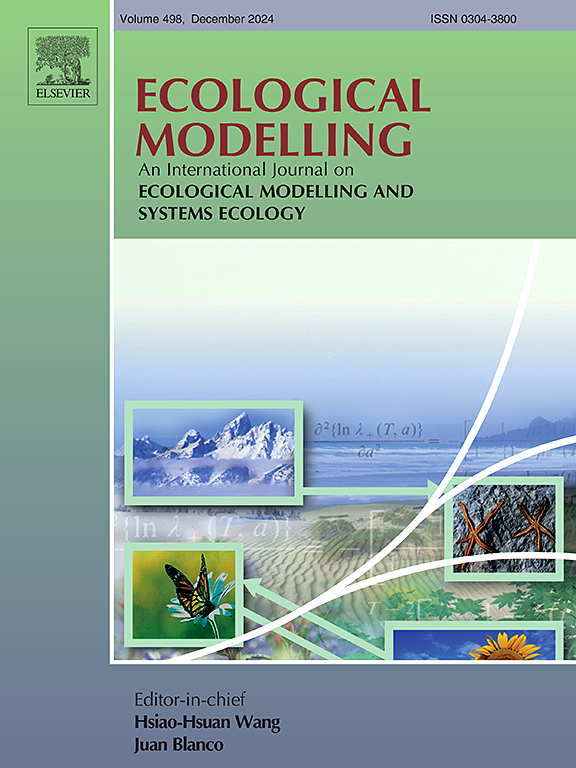封闭生境中捕食者-猎物动态的生态建模与参数估计——以皇家岛为例
IF 3.2
3区 环境科学与生态学
Q2 ECOLOGY
引用次数: 0
摘要
将生态观测结果转化为预测数学模型存在重大困难,其中包括通过简化模型准确捕获生物过程的复杂性、有限的数据可用性、数据测量噪声以及此类模型的参数估计。本文引入了一个随机框架来简化封闭生境中连续时间捕食者-猎物生态系统的模型选择和参数估计问题。我们使用皇家岛历史上的驼鹿狼数量数据作为案例研究来说明建模过程。自1959年以来,每年都会有关于皇家岛国家公园驼鹿-狼关系的生态学研究报告。根据冬季的航空调查,估计了1959年至今狼和驼鹿数量的波动。我们提出了一种基于模型的马尔可夫链蒙特卡罗(MCMC)方法和一种序列蒙特卡罗(SMC)方法,即粒子滤波方法来估计该时间序列。我们从经典的常系数Lotka-Volterra模型开始。虽然该模型使用MCMC算法捕获数据的振荡行为,但由于参数不变,它无法捕获更精细尺度的总体变化和动态。为了提高预测精度,我们将时间序列估计作为一个演化-观测过程,过程函数为变系数Lotka-Volterra方程。我们使用粒子滤波来估计随机过程,同时估计状态和系数。我们还引入了一种局部优化状态预测器,使用最小二乘优化方法来进一步提高估计精度。通过与随机平均粒子估计器的比较,我们证明了该局部预测器在不考虑状态模型复杂性和噪声存在的情况下具有鲁棒性和有效性。最后,我们探讨了框架解释参数的能力。本文章由计算机程序翻译,如有差异,请以英文原文为准。
Ecological modeling and parameter estimation for predator–prey dynamics in a closed habitat: A case study of Isle Royale
Translating ecological observations into predictive mathematical models presents significant difficulties, which include the complexity of accurately capturing biological processes through simplified models, limited data availability, data measurement noise, and parameter estimation for such models. This paper introduces a stochastic framework to facilitate model selection and regularize the parameter estimation problem for continuous-time predator–prey ecological systems in a closed habitat given scarce discrete-time measurements. We use the historical moose–wolf population data on Isle Royale as a case study to illustrate the modeling process. Ecological studies of the moose–wolf relationship in Isle Royale National Park have been reported annually since 1959. Based on aerial surveys during winter, fluctuations in the abundance of wolves and moose were estimated from 1959 to present. We propose a model-based Markov chain Monte Carlo (MCMC) method and a sequential Monte Carlo (SMC) method, a.k.a. particle filter, to estimate this time series. We start with the classic constant-coefficient Lotka–Volterra model. While the model captures the oscillatory behavior of the data with the MCMC algorithm, it fails to capture finer-scale population changes and dynamics due to the constant parameters. To increase the predictive precision, we pose the time series estimation as an evolution–observation process, where the process function is a varying-coefficient Lotka–Volterra equation. We estimate the stochastic process using a particle filter, which simultaneously estimates the states and coefficients. We also introduce a local optimization state predictor using a least-square optimization method to further improve the estimation accuracy. Compared with the stochastic mean-particle estimator, we show that this local predictor is robust and effective, regardless of the complexity of the state model and the presence of noises. Finally, we explore the framework’s ability to interpret parameters.
求助全文
通过发布文献求助,成功后即可免费获取论文全文。
去求助
来源期刊

Ecological Modelling
环境科学-生态学
CiteScore
5.60
自引率
6.50%
发文量
259
审稿时长
69 days
期刊介绍:
The journal is concerned with the use of mathematical models and systems analysis for the description of ecological processes and for the sustainable management of resources. Human activity and well-being are dependent on and integrated with the functioning of ecosystems and the services they provide. We aim to understand these basic ecosystem functions using mathematical and conceptual modelling, systems analysis, thermodynamics, computer simulations, and ecological theory. This leads to a preference for process-based models embedded in theory with explicit causative agents as opposed to strictly statistical or correlative descriptions. These modelling methods can be applied to a wide spectrum of issues ranging from basic ecology to human ecology to socio-ecological systems. The journal welcomes research articles, short communications, review articles, letters to the editor, book reviews, and other communications. The journal also supports the activities of the [International Society of Ecological Modelling (ISEM)](http://www.isemna.org/).
 求助内容:
求助内容: 应助结果提醒方式:
应助结果提醒方式:


